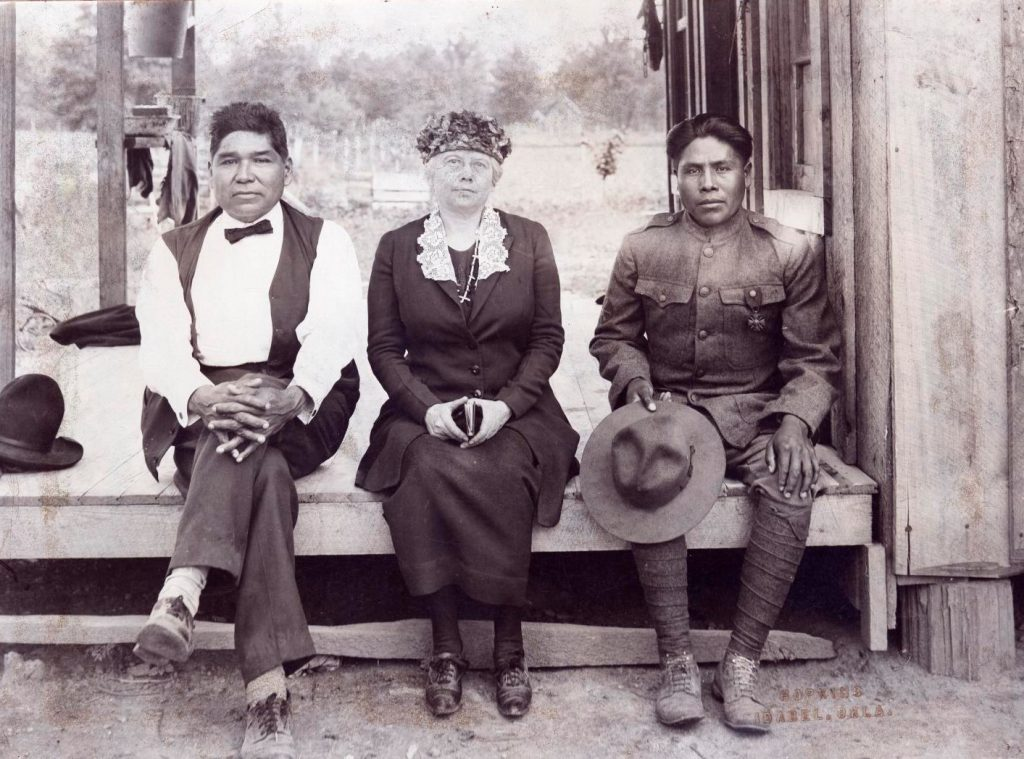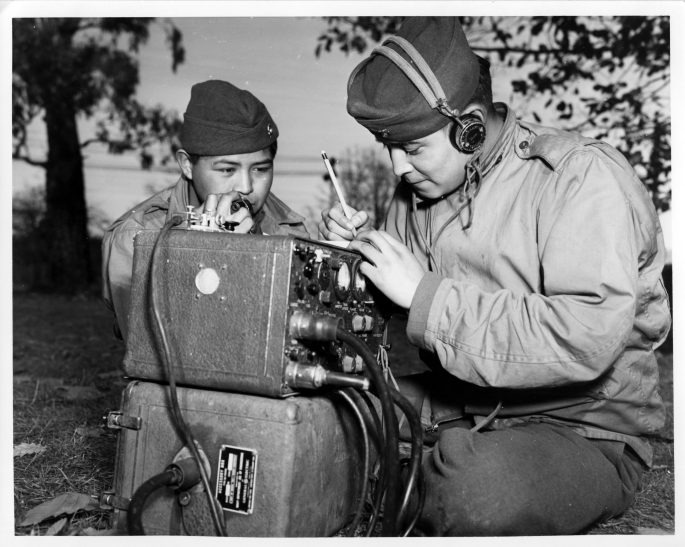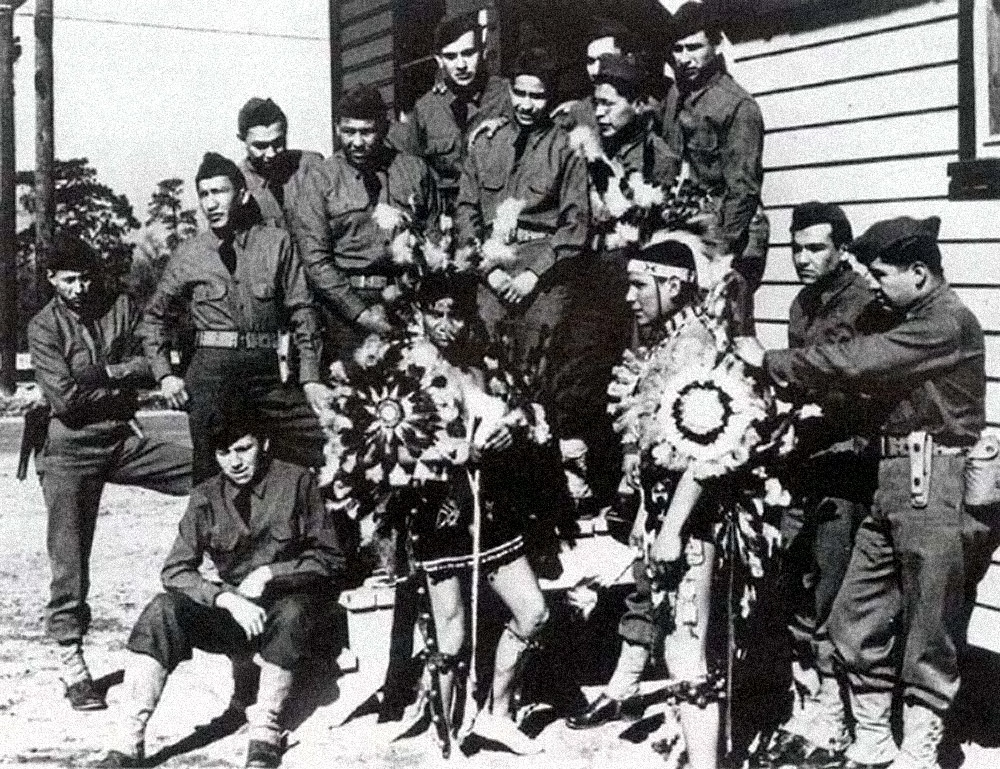As we enter November, it is fitting that we remember the American soldiers who fought for our freedom. Some of them fought not with guns and grenades, but with words. Our code talkers helped the Army keep its secrets, so that more of our soldiers came home to be Veterans, recognized on Veterans Day, November 11.
What we call Veterans Day began as Armistice Day, the day that World War I officially ended in 1918.
At the time that the United States entered World War I in 1917, one-third of the Native population was not recognized by the U.S. government as American citizens. Despite this fact, 12,000 Native Americans volunteered for military service. Some Native Soldiers joined to gain respect as warriors. Others joined because they believed it would prove their patriotism and help them receive citizenship, or to seek a better life for themselves and their families. Few knew that their Native languages would play an important role in the Great War.
At the time that the United States entered World War I in 1917, one-third of the Native population was not recognized by the U.S. government as American citizens. Despite this fact, 12,000 Native Americans volunteered for military service. Some Native Soldiers joined to gain respect as warriors. Others joined because they believed it would prove their patriotism and help them receive citizenship, or to seek a better life for themselves and their families. Few knew that their Native languages would play an important role in the Great War.
Code talking began in World War I, after the U.S. Army realized that the Germans were able to quickly intercept and translate messages sent in plain English. In September 1918, during the Second Battle of the Somme, the 105th Field Artillery Battalion, 30th Infantry Division used a group of Eastern Band Cherokees, to send messages between Allied troops in their Native language. The Germans were not able to translate these messages, keeping the Allied force’s locations and intentions secret. Although this is the earliest documented use of Native Code Talkers by the U.S. Army, anecdotal evidence suggests the Ho-Chunk used their Native language in code in early 1918.
The Cherokee Code Talkers continued their work until the end of the war. Soldiers from the Assiniboine, Comanche, Crow, Hopi, Lakota, Meskwaki (also known as Fox Indians), Mohawk, Choctaw, Seminole, Creek and Tlingit nations were also used. Col. Alfred Wainwright Bloor, commander of the 142nd Infantry, 36th Infantry Division, later stated that his regiment, possessed a company of Indians who spoke twenty-six different languages or dialects, only four or five of which were ever written. This made it almost impossible for Germans to translate.
The Cherokee Code Talkers continued their work until the end of the war. Soldiers from the Assiniboine, Comanche, Crow, Hopi, Lakota, Meskwaki (also known as Fox Indians), Mohawk, Choctaw, Seminole, Creek and Tlingit nations were also used. Col. Alfred Wainwright Bloor, commander of the 142nd Infantry, 36th Infantry Division, later stated that his regiment, possessed a company of Indians who spoke twenty-six different languages or dialects, only four or five of which were ever written. This made it almost impossible for Germans to translate.
The best documented group of World War I Code Talkers are the 16 Choctaw Soldiers from the 142nd and the two from the 143rd Infantries. During an attack that ran from October 26 to 28, 1918, Colonel Bloor had these coordinate attacks, including an artillery attack that took the Germans by surprise and resulted in a much-needed victory for the 36th Infantry Division.
The most famous of the World War I Native Code Talkers was Pvt. Joseph Oklahombi a Choctaw Code Talker with Company D, 1st Battalion, 141st Regiment. During October 1918, Oklahombi and the 23 fellow soldiers in his company came across a German machine gun nest while they were cut off behind enemy lines. Oklahombi and his company rushed to the enemy’s position, captured it, and used the captured machine gun to pin down the enemy. Four days later, the 171 German soldiers surrendered. Oklahombi was awarded the World War I Victory Medal and a Silver Citation Star for his bravery, and France awarded him the Croix de Guerre.
The most famous of the World War I Native Code Talkers was Pvt. Joseph Oklahombi a Choctaw Code Talker with Company D, 1st Battalion, 141st Regiment. During October 1918, Oklahombi and the 23 fellow soldiers in his company came across a German machine gun nest while they were cut off behind enemy lines. Oklahombi and his company rushed to the enemy’s position, captured it, and used the captured machine gun to pin down the enemy. Four days later, the 171 German soldiers surrendered. Oklahombi was awarded the World War I Victory Medal and a Silver Citation Star for his bravery, and France awarded him the Croix de Guerre.
The use of Native Americans as Code Talkers did not end when World War I ended. Several hundred Navajo served as Code Talkers in World War II, many in the Pacific Their language proved unintelligible and unbreakable for Japanese cryptographers, and their radio transmissions were much faster than standard machine-aided shackle encryption. Bill H. Toledo was just 18 years old when he enlisted in the Marine Corps. The Torreon, New Mexico native joined with his uncle Frank Toledo and his cousin Preston Toledo in October 1942. All three would become Code Talkers.
Toledo first showed how valuable the Navajo Code was on Bougainville. He also sent messages on Guam and Iwo Jima before he earned enough points to return to the states. Serving was not easy. Some of his fellow Marines made racist comments about Native Americans. After the Battle of Bougainville, when a Marine mistook him for a Japanese soldier wearing a captured American uniform and nearly killed him, Toledo was also assigned a bodyguard.
As they had in World War I, other tribes continued to serve as Code Talkers in World War II.
As they had in World War I, other tribes continued to serve as Code Talkers in World War II.
Not all soldiers fight with guns and grenades.Words, too, can be a powerful tool in war. But words were not enough for the Native Soldiers who joined to gain the respect of their fellow Americans in the hope that they would receive citizenship. They would have to wait for legal actions. The Snyder Act, also known as the Indian Citizenship Act, which conferred citizenship on Native American people, didn't pass until June 2, 1924, and Native American's right to vote in U.S. elections wasn't recognized until 1948, in the landmark case of Trujillo v. Garley, when an Isleta Puebloan from New Mexico sued for the right to vote. Utah became the last state to remove formal barriers, when they did so in 1962. Still, some states have voter ID laws which require an ID with a physical address. Many people living on reservations do not have physical addresses, only post office boxes.
This Veteran's Day, let's remember those soldiers who did not fight with guns, but with words, and all the others who fought to protect freedoms that they did not share in.
This Veteran's Day, let's remember those soldiers who did not fight with guns, but with words, and all the others who fought to protect freedoms that they did not share in.
Jennifer Bohnhoff is a retired educator who now writes historical fiction for middle grade through adult readers. You can read about her and her books here, on her website.









No comments:
Post a Comment